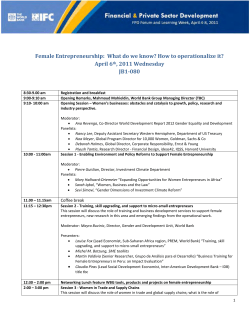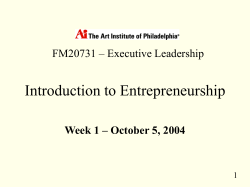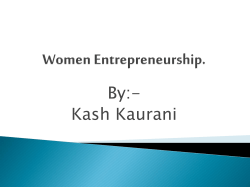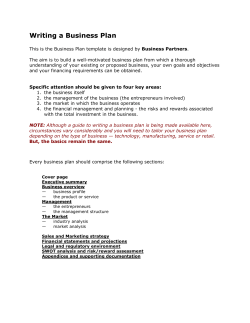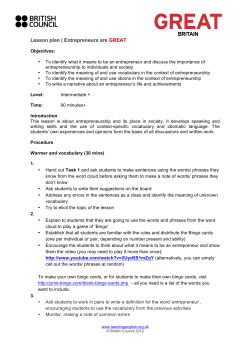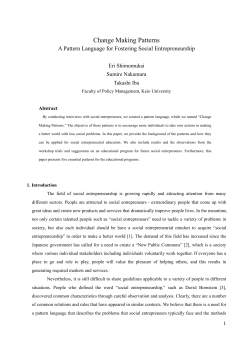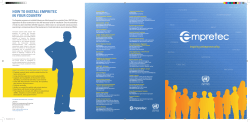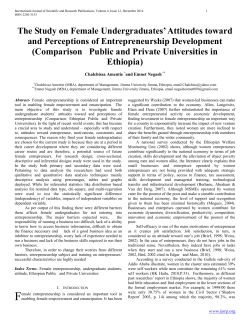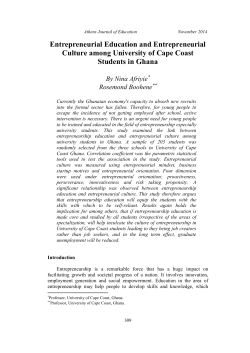
Critical Thinking and the Creative Personality COEUR - BCM Business Creativity Module
COEUR - BCM Business Creativity Module Critical Thinking and the Creative Personality Carolyn McNicholas Aberdeen Business School, RGU Key Questions • How do creative/ entrepreneurial people differ? • What makes one creative/ entrepreneurial? • Can anyone be creative/ entrepreneurial? • Do you need special skills and characteristics to be an entrepreneur? • Are entrepreneurs born or made? Schumpeter’s Entrepreneur • The instrument of change, the agent who introduces innovations: new products, new ways of manufacturing, new sales techniques, new types of equipment • Creative disruption involves technologies or innovations that change the world........... Personality Traits Strong need for achievement (Nach) McCelland 1965 • high achievers • spend time considering how to do a job better or how to accomplish something important to them. • They actively seek out opportunities to take responsibility and • They welcome feedback on their actions Risk taking propensity • Medium, calculated risk takers • Avoid high and low risk situations • Ability to evaluate risk Personality Traits • Locus of control Rotter 1966 • desire to be in control of their own fate • High internal LOC • the achievement of a goal is dependent on their own behaviour • Tolerance of ambiguity Schere 1982 • • • • have an open mind, respond quickly to change, need to know only the key facts have a flexible attitude Personality Traits • • • • • • • • Desire for autonomy Birley and Westhead 1993 high need for independence Smith 1967- fear of external control Determination Initiative Creativity Self confidence Trust Personality Traits Chell, Haworth and Brearley (1994) & Chell 2008 • • • • • • • • Opportunity recognition/ Opportunistic Entrepreneurial self-efficacy (ESE) Social competence Intuitive Innovative Imaginative Proactive Agents of change The ‘Big Five’ based on Costa and McCrae’s (1992) model of personality structure Neuroticism Extraversion Openness Agreeableness Conscientiousness Chell 2008 p.123 Anxiety, angry hostility, depression, self-consciousness, impulsiveness, vulnerability Warmth, gregariousness, assertiveness, activity, excitement-seeking, positive emotions Fantasy, aesthetics, feelings, actions, ideas, values Trust, straightforwardness, altruism, compliance, modesty, tendermindedness Competence, order, dutifulness, achievement-striving, self-discipline, deliberation The Personality Approach Observations are that: • Some personality traits can be acquired by people • Some traits eg high energy, emotional stability are innate • Most entrepreneurs do not possess all of the ideal personality traits • The validity and reliability of personality scales are questioned The Personality Approach • Entrepreneurs are not homogenous • Gender, age, social class, nationality and education make a difference • Environment and cultural influences must also be taken into account • Entrepreneurial decision making is based on the interaction of many factors (motivations, stage in life cycle, personal economic context) Background of Entrepreneurs Entrepreneurs are: • Female • Immigrant • Socially oriented • Family oriented • Rurally based • Young and old • Life style oriented (hobby/part time) • Serial Entrepreneurs The 10 Ds Bygrave (2010) • • • • • Dreamers Decisive Doers Determined Dedicated • • • • • Devoted Details Destiny Dollars Distribute Critical Attributes for Success Brannick 1995 • • • • • • • • Numerical ability 1% Verbal ability 3% Professional marketing qualification 5% Computer literacy 5% Imagination 17% Observational powers 18% Personal judgement 24% Ability to get on with others 27% • http://www.youtube.com/watch?v=Tod1moy8VZM Desirable and Acquirable Attitudes Timmons (2008) contd Commitment and determination • Tenacity and decisiveness • Able to commit quickly • Disciplined • Persistent in solving problems • Willing to undertake personal sacrifice Leadership • Self starter • Team builder and hero • Share the wealth • Integrity and reliability • Superior learner and teacher Desirable and Acquirable Attitudes Timmons (2008) • • • • Opportunity obsession Have intimate knowledge of customers needs Market driven Obsessed with value creation and enhancement • • • • • • Tolerance of risk, ambiguity and uncertainty Calculated risk taker Risk minimiser/ sharer Tolerant of uncertainty Tolerant of stress Able to resolve problems and integrate solutions Desirable and Acquirable Attitudes Timmons (2008) contd • • • • • Creativity, self-reliance & ability to adapt Creative and lateral thinker Ability to adapt and change; creative problem solver Ability to learn quickly Rely on own judgement & lack of fear of failure • • • • • Motivation to excel Goal and results orientation Low need for status and power Aware of weaknesses and strengths Have perspective and a sense of humour Characteristics of Entrepreneurs Kaplan 2009 • Passionately seek to identify new opportunities • Pursue opportunities with discipline and focus on a limited number of projects • Focus on action and execution • Involve and energise networks of relationships Entrepreneurs • Experience success and failure • Feel good about themselves, their work and the potential rewards • Enjoy a challenge • Take pride in their work • Find their work invigorating/energising/ meaningful • Think the unlikely, do the unreasonable So what is an Entrepreneur? • “Who is the entrepreneur ?” may be the wrong question • Why successful entrepreneurs think the way they do, might be better? • Thinking processes can be taught, so we can all be entrepreneurs if we learn how to develop and evaluate opportunities Cognitive abilities Westhead, Wright & McElwee 2011 • • • • • Information acquisition and dissemination Intelligence, ability with information Sense making Unlearning Implementation and improvisation, autonomous behaviour, experimentation, reflection and action Entrepreneurs Cognitive Processes (Palich & Bagby 1995) • Entrepreneurs do NOT perceive themselves as being more pre-disposed to taking risks than managers • Entrepreneurs interpret equivocal data in a more positive way than managers – Strengths versus weaknesses – Opportunities versus threats Entrepreneurs Cognitive Processes (Palich & Bagby 1995) • “What each man wishes, that he also believes to be true” - Demonsthenes • Entrepreneurs categorise situations as having strengths and opportunities, because the positive attributes, are more salient to them What is Critical Thinking? Market share High Low High Stars Question marks Low Cash cows Dogs Market growth Figure 4.12a The original Boston Consulting Group Matrix (BCG) This matrix is (in my opinion): • Subjective, so needs analysis • Useful for small and large organisations alike • Relatively easy to apply, but improves with discussion and feedback • Helps to determine overall positioning This matrix is (according to Zufan, 2000) identified as: • Objective • Mainly applicable to large organisations • Difficult to apply So, what someone else says or writes is not always agreed, accurate or easily determined - who is right, who is wrong and why? Critical Thinking Quote (1) "For myself, I found that I was fitted for nothing so well as for the study of truth; as having a mind nimble and versatile enough to catch the resemblances of things … and at the same time, steady enough to fix and distinguish their subtler differences…" Francis Bacon (1605) Critical Thinking Quote (2) “Critical thinkers: distinguish between fact and opinion; ask questions; make detailed observations; uncover assumptions and define their terms; and make assertions based on sound logic and solid evidence” Ellis, D. ‘Becoming a Master Student’ (1997) Components of Critical Thinking 1. A set of skills to process and generate information and beliefs, and 2. The habit, based on intellectual commitment, of using those skills to guide behaviour It is contrasted with the mere acquisition and retention of information alone, (because it involves a particular way in which information is sought and treated) Core Critical Thinking Skills Interpretation Analysis Critical Thinking Self-Regulation Evaluation Inference Explanation Source: Facione, P. A (1998) Attributes Of A Critical Thinker Ferrett 1997 • • • • • Asks pertinent questions Can/does admit a lack of understanding or information Has a sense of curiosity Is interested to find new solutions Is willing to examine beliefs, assumptions, and opinions and weigh them against facts • Listens carefully to others and can provide feedback • Seeks evidence to support assumptions and beliefs • Can/does adjust opinions when new facts are found Hemispheres of the brain Ornstein 1896 The left side handles language, logic and symbols. • Information processing; step by step • Systematic thinking The right side takes care of the body's emotional, intuitive and spatial functions. • Information processing; intuitive • Unsystematic thinking http://en.wikipedia.org/wiki/The_Spinning_Dancer Right brain thinking Lewis 1987 • • • • • • • • ask if there is a better way of doing things; challenge custom, routine and tradition; be reflective – often deep in thought; play mental games, trying to see an issue from a different perspective; realise that there may be more than one “right” answer; see mistakes and failures as pitstops on the route to success; relate seemingly unrelated ideas to a problem to generate a solution; and see an issue from a broader perspective, but have the ability to focus on an area in need of change. Critical and Creative thinking Kirby 2004 Conclusions • The identification and exploitation of opportunities is a complex and interactive process • The entrepreneur is just one of many contributing factors • They can however be the critical catalyst that spots the opportunity and begins the process of firm creation Entrepreneurial skills • • • • • • • • communication skills, especially persuasion; creativity skills; critical thinking and assessment skills; leadership skills; negotiation skills; problem-solving skills; social networking skills; and time-management skills. • • • • • • • • • • • • Deakins, D and Freel, M. 2009. Entrepreneurship and Small Firms. 5th Edition, McGraw Hill. Kuratko, D, & Hodgetts, M 1995 Entrepreneurship: Theory, Process and Practice Thomson Burns, P 2007 Entrepreneurship and Small Firms 2nd ed. Palgrave Macmillan CHELL, E 2008 The entrepreneurial personality: a social construction HULL, D., BOSLEY, J., UDELL, G 1980 Renewing the hunt for the heffalump: identifying potential entrepreneurs by personality characteristics, Journal of Small Business, 18: 11–18. McCELLAND, D. C. 1965 Achievement motivation can be developed, Harvard Business Review, 43: 6–24, 178. PALICH, L. E. and BAGBY, D. R. (1995) Using cognitive theory to explain entrepreneurial risk-taking – challenging conventional wisdom, Journal of Business Venturing, 10: 425–438. TIMMONS, J. A., SMOLLEN, L. E. and DINGEE, A. L. M. (1985) New Venture Creation, (2nd ed.), Homewood, IL: Irwin. ZHANG, Z, ZYPHUR, M, NARAYANAN, J 2009 The genetic basis of entrepreneurship:effects of gender and personality. Organizational Behavior and Human decision processes110 pp93-107 ZHAO, H, SEIBERT, S., LUMPKIN, G 2010 The relationship of personality to entrepreneurial intentions and performance: A meta analytic review Journal of Management 36(2) pp381-404 KAPLAN, J 2009 Patterns of entrepreneurship. 3rd ed. New Jersey: Wiley & Sons Bygrave, W & Zacharakis A, 2010 The portable MBA in Entrepreneurship. • • • • • • • • • • • • • Timmons, J & Spinelli, S 2008 New venture creation: Entrepreneurship for the 21st Century STOREY, D & GREENE, F 2010 Small business and entrepreneurship Prentice Hall CROMBIE, I., 1996 The Pocket Guide to Critical Appraisal.London: PMJ Publishing Group VAN DEN BRINK-BUDGEN,R., 2000 Critical Thinking for Students. Oxfor COTTRELL, S., 2005 Critical Thinking Skills Basingstoke:Palgrave Lewis, D. (1987), Mind Skills: Giving Your Child a Brighter Future, Souvenir Press, London Ornstein, R. (1986), The Psychology of Consciousness, Penguin, Harmondsworth, David A. Kirby, (2004) "Entrepreneurship education: can business schools meet the challenge?", Education + Training, Vol. 46 (8/9), pp.510 – 519 Ferrett, S. (1997) Peak Performance CHELL, E (2008) The entrepreneurial personality; a social construction. 2nd ed. Routledge http://www.get2test.net/index.htm Online test of entrepreneurship http://www.personalitytest.net/quizzes/quiz3/index.htm Online test of right/ left brain • • • • • • • • • • STEFFENS, P., DAVIDSSON, P, FITZSIMMONS, J 2009 performance configurations over time: implications for growth and profit oriented strategies Entrepreneurship Theory and Practice January pp125-148 FRANK, H., LUEGER, M., KORUNKA, C 2007 The significance of personality in business start up intentions, start up realization and business success Entrepreneurship & Regional development 19 May pp227-251 KOR, Y., MAHONEY, J., MICHAEL, S 2007 Resources, capabilities and entrepreneurial perceptions Journal of Management Studies November pp1187-1212 LUCHSINGER, V., BAGBY, D 1987 Entrepreneuship and Intrapreneurship: Behaviors, comparisons and contrasts SAM Advanced Management Journal. Summer pp10-13 BIRLEY, S. and WESTHEAD, P. (1993) A comparison of new businesses established by “novice” and “habitual” founders in Great Britain, International Small Business Journal, 12: 38–60. SMITH, N. R. (1967) The Entrepreneur and His Firm: The Relationship Between Type of Man and Type of Company, East Lansing, MI: Michigan State University Press ROTTER, J. B. (1966) Generalised expectancies for internal versus external control of reinforcement, Psychological Monographs, Whole No. 609, 80: 1–28. SSCHERE, J. C. (1982) Tolerance of ambiguity as a discriminating variable between entrepreneurs and managers, Academy of Management Proceedings, 45: 404–408. DELMAR, F., DAVIDSSON, P. 2000 Where do they come from? Prevalence and characteristics of nascent entrepreneurs Entrepreneurship and Regional Development1 21–23. WESTHEAD, P., WRIGHT., W, MCELWEE, G 2011 Entrepreneurship; perspectives and cases. Harlow: Prentice Hall
© Copyright 2025


